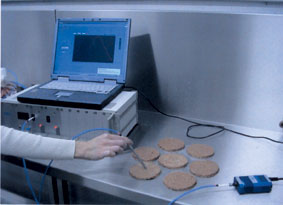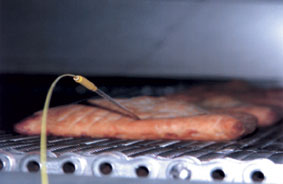| 2003 |

|
YEAR BOOK |
University of Limerick
|
Online intelligent colour and temperature measurements used to control the process of cooking food
|

Grading the quality of a product - e.g. in terms of colour - ensures consistency in the product. Factors such as colour have a huge influence over a customer decision in purchasing a product, as they often have preconceived notions of how it should look - e.g. roast chickens must be golden, flame-grilled hamburgers must have black lines, and cooked sausage must be a rich brown. The fact that the food is cooked to a core temperature recommended by food safety authorities is taken for granted by the customer, but for the manufacturer it is a critical parameter indicating that all bacteria are killed and food poisoning is avoided. Therefore, it is clear that both colour and temperature are used to determine if a product is correctly cooked.

The temperature measurement requires a specially doped optical fibre whereby stimulation at a certain wavelength of light, 785nm (infra-red), causes it to absorb energy and emit light at a higher wavelength, 1060nm. When the stimulation is effectively 'cut off', the emission decays rapidly, but at a certain rate which is dependant on the surrounding temperature. By measuring that decay time, it is possible to determine the food sample temperature. This temperature measurement technique has been researched and developed by the collaborating research institution, City University, London, UK.
These sensor probes can be made to be as small as 2.5mm (including the stainless steel protective cover) and thus allow unobtrusive internal measurements of food (i.e. they don't cause physical damage to the food sample). This allows online measurements inside the ovens, thus removing the need to take random samples out for testing that will be subsequently thrown away, as well as speeding up the cooking process.
Contact: Dr Elfed Lewis, E-mail: [email protected] ;
Dr William Lyons, E-mail: [email protected] ;
Marion O'Farrell, E-mail: Marion.O'[email protected]